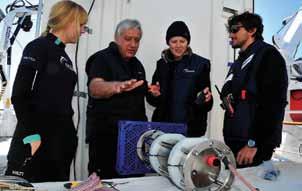
4 minute read
Financial Summary
© OCEANA | Xavier Pastor

THE RANGER ExPEDITION
In the summer of 2011, Ranger sailed for six weeks through the western Mediterranean and the Northeast Atlantic to document important seamounts and marine environments.
Oceana uses the photos, video and science from its expeditions to support its policy campaign objectives. For the 2011 Ranger expedition, Oceana collaborated with Portuguese government officials and scientists to photograph, film and research the Gorringe Bank, a little-explored seamount and an oasis of biodiversity southwest of Portugal.
Oceana gathered the first-ever images of this region in 2005. Oceana built on its last effort by using an underwater robot (ROV) and documented areas more than 2,500 feet below the surface of the ocean. The ROV recorded high-resolution videos and photos of this seamount and many others located in the Mediterranean Sea. The images will be used to support the creation of more protections for the Gorringe Bank and other areas.

HANSE ExPLORER ExPEDITION
For two months in the spring of 2011, Oceana’s first Baltic Sea expedition explored the brackish sea’s frigid expanses. The photos and scientific findings from the expeditions will help Oceana make the case for needed protections for the Baltic Sea.
Using divers, an underwater robot and a Van Veen dredge to take seabed samples, the crew of the Hanse Explorer documented the underwater biodiversity in the waters of every country bordering the Baltic Sea – the first time any environmental organization has done so.
Much of the Baltic Sea suffers from eutrophication, which causes massive cyanobacteria blooms and in worst cases leads to oxygen depletion. The blooms caused by eutrophication give the water a green sheen, limiting visibility to almost zero in many places. Throughout the expedition, the crew took sediment samples and measured oxygen levels in order to determine the most threatened parts of the sea.
The oxygen-depleted areas were lacking in wildlife, but many other areas showed healthy ecosystems and variety of different species. In the Kattegat inlet, for example, the crew saw healthy ecosystems and a variety of marine life, including sea kelp, starfish, mussels and sea snails. Oceana has proposed that these areas be included in a network of marine protected areas.
© OCEANA | Carlos Minguell
© OCEANA | Carlos Minguell
Left: The Oceana Ranger in the Mediterranean. Top: The Hanse Explorer. Bottom: Crew members on deck on the Hanse Explorer.

© OCEANA | Eduardo Sorensen

EASTER ISLAND AND SALAS Y GóMEz ISLAND
In early 2011, Oceana collaborated with National Geographic and the Chilean Navy in a unique partnership exploring the waters near Easter Island and Salas y Gómez Island. The expedition was the first to describe the fish and wildlife in the entire area surrounding these islands.
Oceana documented the impacts of overfishing in Easter Island. In nearby Salas y Gómez Island, another remote Pacific outpost, Oceana found three times as many fish despite otherwise equivalent conditions. Salas y Gómez is home to a healthy colony of sharks, which is a good sign of a healthy ecosystem, while Easter Island has almost none.
In 2010, Oceana was instrumental in the creation of a fully protected marine reserve in the waters of Salas y Gómez Island. The evidence from the Easter Island and Salas y Gómez expedition will help Oceana in the fight to expand the reserve, helping Easter Island’s marine life to rebound and aiding the local Rapa Nui fishing community.
ExPLORING THE PACIFIC
In the summer of 2011, Oceana launched a three-stage expedition on the West Coast of the United States. Oceana used remote operated vehicles (ROVs) and cameras to capture surface and underwater footage and support Oceana’s efforts to protect these special places. In California’s Monterey Bay, the ROV documented shale beds, rocky pinnacles and recently-created marine protected areas. The ROV captured pink gorgonian corals, rock walls blanketed in colorful strawberry anemones, sponges and other living habitat essential for abundant fish populations. In Oregon, Oceana documented the large area of rocky reef just south of Cape Arago.
The expedition concluded in the San Juan Islands of Washington’s Puget Sound. The expedition team found yellow branching sponges, large anemones, scallops, copper rockfish, quillback rockfish, kelp greenlings and more. Many of the areas Oceana explored are still open to bottom trawling, and others are threatened by efforts to re-open the seafloor to this destructive fishing practice. The footage captured will be an integral tool in Oceana’s efforts to protect these special ocean places.
© OCEANA | Eduardo Sorensen
Left: Abundant fish near Salas y Gomez Island. Right: A shark near Salas y Gomez Island.










